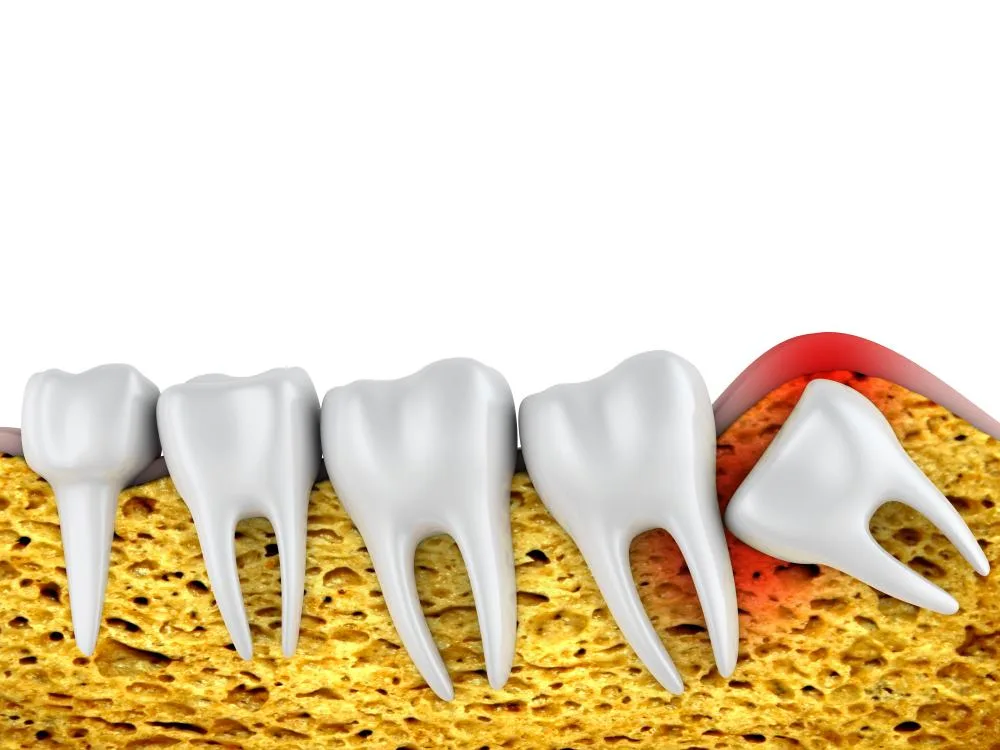Dry socket syndrome is one of the most painful yet preventable complications following a tooth extraction, particularly after the removal of wisdom teeth. Clinically referred to as alveolar osteitis, this condition occurs when the blood clot that normally forms in the socket either dissolves too early or becomes dislodged. Without that clot, the underlying bone and nerves are exposed, leading to intense pain and delayed healing.
While most extractions heal uneventfully, dry socket syndrome affects a small percentage of patients—especially those who smoke, fail to follow post-op instructions, or undergo difficult extractions. Symptoms typically arise a few days after the procedure and can persist for several days if not treated properly.
This guide provides a comprehensive overview of what dry socket syndrome is, how to recognize it, ways to prevent it, and how it’s typically treated. Whether you’re preparing for an extraction or dealing with discomfort after one, understanding this condition is key to recovery and comfort.
Dry Socket Syndrome: What Is It and Why Does It Happen?
Dry socket syndrome is a painful dental condition that develops when the blood clot at the site of a tooth extraction fails to form or is prematurely lost. This blood clot plays a vital role in protecting the exposed bone and nerves in the empty socket while new tissue grows to close the wound.
Without the clot, the bone is directly exposed to the oral environment, resulting in inflammation, pain, and a high risk of infection. This condition typically develops two to four days after the tooth is removed and is most common in the lower molars—especially impacted wisdom teeth.
Several factors can contribute to dry socket syndrome, including smoking, using a straw, spitting forcefully, or failing to follow aftercare guidelines. The condition is not the same as a typical post-extraction infection. Instead, it is a mechanical and biological failure of early wound healing.
Understanding why dry socket occurs helps patients appreciate the importance of gentle care and adherence to instructions after a tooth is extracted. Prompt recognition and professional treatment can significantly reduce discomfort and speed up healing.
Symptoms of Dry Socket Syndrome: How to Spot It After Extraction
The symptoms of dry socket syndrome are usually unmistakable. The most telling sign is a sharp, throbbing pain that begins two to four days after the extraction. This pain often radiates from the extraction site to the ear, temple, or eye on the same side of the face, making it more intense than typical post-op soreness.
Patients may also notice an empty-looking socket where the blood clot should have been. Instead of a dark clot, the exposed white bone may be visible. This is a clear sign that the protective barrier has been lost, leaving the area vulnerable to irritation and bacterial contamination.
Other symptoms can include a bad taste in the mouth, foul breath, and swelling of nearby tissues. The pain from dry socket is generally not well-controlled by over-the-counter painkillers and tends to worsen rather than improve each day.
If these symptoms arise, it’s important to contact your dental provider as soon as possible. Early intervention with appropriate treatment can prevent complications and help control pain effectively.
Dry Socket Syndrome: Risk Factors That Increase Your Odds
Certain behaviors and health conditions significantly increase the likelihood of developing dry socket syndrome. Smoking is one of the most well-established risk factors. The chemicals in tobacco interfere with blood flow and clot formation, while the act of inhaling can dislodge a fragile clot.
Poor oral hygiene and existing infections in the mouth also increase risk, as bacteria can interfere with healing. Patients who have had a traumatic or complicated extraction—such as deeply impacted or broken teeth—are more prone to experiencing dry socket.
Hormonal changes, particularly in women taking oral contraceptives, have also been linked to higher dry socket rates. Additionally, patients who fail to follow post-operative care instructions, such as avoiding rinsing or eating on the surgical side, are more vulnerable.
Even age can be a factor. Adults over 30 may have denser bone that makes extraction more difficult, increasing trauma and slowing healing.
Understanding these risk factors helps patients and providers take proactive steps to minimize risk. From pre-surgical planning to post-op care, prevention starts with awareness and communication.
How to Prevent Dry Socket Syndrome After Tooth Extraction
Preventing dry socket syndrome begins before the extraction takes place. A thorough consultation with your dentist or oral surgeon allows you to discuss risk factors and receive specific post-operative instructions tailored to your health and procedure type.
Immediately after the extraction, it’s critical not to disturb the surgical site. Avoid rinsing your mouth vigorously, spitting, or drinking through a straw for at least 48 hours. These actions can dislodge the blood clot that forms in the socket.
Smoking should be strictly avoided before and after the procedure, as it increases the risk of clot loss and delays healing. Alcohol and carbonated drinks are also discouraged, as they can irritate the wound.
Eating soft, lukewarm foods and avoiding chewing on the side of the extraction site will help protect the clot. Proper oral hygiene is still important, but be gentle and avoid brushing near the surgical area for the first few days.
Your provider may recommend a medicated mouth rinse or pain relievers to aid in recovery. Following these steps carefully can greatly reduce the chance of developing dry socket syndrome and ensure a smoother healing process.
What Not to Do After Extraction: Avoiding Dry Socket

Preventing dry socket syndrome largely depends on what patients avoid in the first 48 hours after a tooth extraction. This critical window allows a blood clot to form and stabilize in the socket. Disrupting this process through daily habits or actions can lead to painful complications.
One of the most common mistakes is using a straw. The suction created can easily dislodge a fragile clot and expose the bone underneath. Similarly, spitting forcefully or rinsing the mouth too soon—especially with salt water or antiseptics—can wash the clot away before it has a chance to mature.
Smoking is another major factor. Both the nicotine and the physical motion of inhalation interfere with clot retention. Patients are strongly advised to avoid smoking entirely for at least three days post-surgery, if not longer.
Other risky behaviors include vigorous physical activity, touching the extraction site with the tongue or fingers, and consuming very hot foods or beverages that may dissolve or disturb the forming clot.
Understanding these “don’ts” and strictly following your dentist’s instructions can dramatically reduce the risk of developing dry socket syndrome. Clear, written post-op guidelines can serve as a helpful reminder during recovery.
How Is Dry Socket Syndrome Diagnosed by Your Dentist?
Diagnosis of dry socket syndrome typically begins with a physical examination and a review of the patient’s symptoms. A dentist or oral surgeon will ask when the pain began, whether it worsened after initial improvement, and what kind of discomfort the patient is experiencing.
The most common signs include severe, localized pain at the extraction site that radiates to other areas of the face, and the absence of a visible blood clot in the socket. Instead of dark tissue filling the hole, the patient may have exposed white bone, which is a clear visual indicator of the condition.
Foul odor and bad taste in the mouth may also accompany dry socket, suggesting bacterial contamination or necrotic tissue. In some cases, the dentist may gently flush the area to confirm the absence of a clot or to rule out infection or retained tooth fragments.
Imaging, such as dental X-rays, may be used to ensure no root tips or bone fragments were left behind. However, diagnosis is usually clinical and based on direct observation and patient-reported symptoms.
Prompt diagnosis is crucial for effective management. The earlier dry socket syndrome is recognized, the sooner pain can be relieved and healing can begin.
Dry Socket Syndrome Treatment: What to Expect at the Dental Office
When dry socket syndrome is diagnosed, treatment typically focuses on relieving pain, reducing inflammation, and encouraging healing. This is usually done in the dental office through a short, non-invasive procedure.
The first step is gently flushing the socket with a sterile solution to remove any food debris or bacterial buildup. This helps prevent infection and creates a clean environment for healing. After irrigation, the dentist may apply a medicated dressing or paste into the socket.
These dressings often contain a soothing anesthetic and antiseptic agents that provide almost immediate pain relief. Depending on the material used and the severity of the condition, the dressing may be changed every few days until the discomfort subsides and tissue begins to regenerate.
Pain medication may also be prescribed to manage symptoms at home. Antibiotics are typically not needed unless signs of systemic infection are present.
In most cases, dry socket syndrome improves within a few days once treatment begins. However, follow-up appointments are important to monitor progress and ensure no further complications arise.
Home Care for Dry Socket Syndrome: Managing Pain and Healing
While treatment of dry socket syndrome starts in the dental office, ongoing care at home plays a critical role in recovery. Pain management is usually the top priority, followed by maintaining cleanliness in the affected area.
Patients are often instructed to avoid disturbing the socket further. That means no rinsing or brushing directly over the area unless specifically told otherwise. Warm salt water rinses may be introduced a few days into healing to help cleanse the mouth without disrupting sensitive tissues.
Over-the-counter pain relievers like ibuprofen or acetaminophen may be used as recommended. In cases of more severe discomfort, your dentist might prescribe stronger medication.
It’s also important to maintain hydration, stick to soft foods, and avoid smoking or alcohol, as these can delay healing and worsen symptoms. Applying cold compresses on the outside of the face during the first 24 hours may help reduce swelling and provide temporary relief.
Monitoring the site for signs of improvement is key. Pain should gradually diminish over a few days. If symptoms worsen or do not improve, follow up with your dentist to reassess the treatment plan.
Which Pain Relief and Dressings Work Best for Dry Socket Syndrome?
There are several pain relief and dressing options used to treat dry socket syndrome, and their effectiveness can vary depending on the patient and the severity of the condition. The goal is always the same: to alleviate pain, protect the exposed bone, and support the healing process.
One of the most commonly used treatments is a medicated dressing made with eugenol (a compound derived from clove oil), which has both anesthetic and antiseptic properties. This material is placed into the socket and often provides fast, long-lasting relief. Dressings may need to be replaced every one to three days until symptoms resolve.
Alternative treatments include calcium hydroxide-based pastes or resorbable collagen sponges soaked in antiseptic solution. Some dentists also use custom gels containing anti-inflammatory agents or topical anesthetics to coat the socket.
Laser therapy is emerging as a non-invasive treatment that reduces inflammation and promotes faster healing by stimulating blood flow. It may be offered in specialized practices and can complement traditional care.
Selecting the best treatment depends on patient tolerance, medical history, and available resources. Many cases respond well to traditional eugenol-based dressings, but advanced cases may benefit from newer approaches.
Efficacy of Treatments: Laser Therapy, Zinc Oxide Eugenol & PRGF
Several treatment options are available for managing dry socket syndrome, ranging from traditional methods to more modern regenerative therapies. Evaluating their effectiveness helps patients and providers choose the most appropriate approach for each case.
Zinc oxide eugenol dressings remain one of the most widely used treatments due to their ease of application and rapid pain relief. Eugenol acts as a local anesthetic and anti-inflammatory agent, while the zinc oxide base provides structural support. These dressings typically offer relief within minutes and remain effective for several days.
Laser therapy is a newer, non-invasive option that uses low-level laser energy to reduce inflammation and stimulate blood flow in the affected area. This treatment may decrease healing time and is well tolerated by most patients. It’s especially helpful for those who want to avoid repeated packing of the socket.
PRGF, or Plasma Rich in Growth Factors, is a regenerative therapy derived from the patient’s own blood. The concentrated plasma is placed in the socket to encourage soft tissue regeneration and reduce pain. Although more costly and less widely available, PRGF has shown promise in reducing healing time and improving patient comfort.
Each method has its own benefits, and the choice often depends on the severity of the condition, access to advanced technologies, and patient preference. Dentists may also combine therapies for optimal outcomes.
How Long Does Dry Socket Syndrome Last? Healing Timeline

The discomfort caused by dry socket syndrome can be intense, but the good news is that it usually resolves within a week to ten days with proper care. Pain often begins two to four days after the extraction and peaks within the first 48 hours of symptom onset.
Once treatment is initiated—whether with medicated dressings, rinses, or laser therapy—patients typically experience noticeable relief within a day or two. Continued improvement follows as soft tissue regeneration occurs over the socket.
While the healing process varies from person to person, most people find that pain significantly reduces within three to five days of starting treatment. Complete soft tissue coverage of the socket may take slightly longer but is typically complete by the second week.
It’s important to avoid disturbing the area during recovery. Activities such as smoking, spitting, or aggressive oral hygiene can delay healing and prolong symptoms.
If discomfort persists beyond ten days, or if new symptoms develop—such as swelling, fever, or pus discharge—it may indicate a secondary issue that requires additional evaluation. Regular follow-ups with your dental provider can ensure that the socket is healing as expected.
Can Dry Socket Syndrome Recur? Risks and How to Prevent Future Episodes
Dry socket syndrome is typically a one-time event, but recurrence is possible—especially in patients who undergo multiple extractions or have risk factors such as smoking or poor post-operative compliance. Understanding what causes recurrence helps ensure it doesn’t happen again.
The main driver of recurrence is the failure of a blood clot to form or remain in place. This can result from mechanical disruption—like drinking through a straw—or from biological factors, such as reduced blood flow or infection. Smoking continues to be the top preventable risk.
Patients who’ve had dry socket in the past may be more likely to develop it again, particularly if the same risk factors are present. Dentists often take extra precautions with these individuals, including using sutures, prescribing medicated rinses, or applying clot-retention agents.
To minimize recurrence, it’s essential to follow all aftercare instructions, including dietary restrictions, activity limitations, and oral hygiene guidelines. Avoiding tobacco products and informing your dentist of your medical history can also help tailor preventive strategies.
With careful planning and compliance, the risk of developing dry socket syndrome again can be significantly reduced.
It might interest you –> Sensitive Teeth
When a Dry Socket Masks Another Issue: Ruling Out Complications
Although dry socket syndrome is a common post-extraction complication, it’s important to recognize when symptoms may indicate something more serious. In rare cases, similar pain or inflammation may signal a deeper problem such as infection, retained root fragments, or delayed healing due to systemic conditions.
One potential issue is alveolar osteomyelitis—a bone infection that may initially mimic dry socket symptoms but worsens over time and involves swelling, fever, or pus discharge. An undiagnosed fracture of the surrounding bone or retained bone chips can also produce persistent pain that doesn’t respond to standard dry socket treatment.
If pain doesn’t begin to subside within several days of treatment, or if it worsens despite professional care, a follow-up visit is warranted. Your dentist may take an X-ray to rule out deeper infections or foreign material in the socket.
Another concern is nerve involvement. Though rare, irritation of the inferior alveolar or lingual nerve can lead to persistent numbness or tingling, which should be promptly addressed by a specialist.
While dry socket syndrome is uncomfortable, it’s usually self-limiting and treatable. However, being aware of what could be mistaken for dry socket ensures any additional complications are caught early and handled appropriately.
For your information –> Dental Implants Turkey
Guidelines for Patient Education: Talking Dry Socket with Your Dentist
Educating patients about dry socket syndrome is a vital part of the extraction process. A well-informed patient is more likely to follow aftercare instructions, recognize warning signs, and seek help early—resulting in better outcomes and reduced complications.
Pre-operative discussions should include an explanation of what dry socket is, when it typically occurs, and how it differs from normal post-extraction pain. Highlighting risk factors—such as smoking, poor oral hygiene, and certain medications—helps patients understand their personal risks.
Clear, written aftercare instructions are critical. These should include specific recommendations on what to eat, how to clean the mouth, which activities to avoid, and when to contact the office. Visual aids or videos may further improve understanding.
During follow-up visits, dentists should ask about pain progression and assess healing. If symptoms of dry socket syndrome appear, explaining the treatment process calmly can help reduce patient anxiety.
Patients should also be encouraged to ask questions and share concerns. Open communication builds trust and ensures that any complications are addressed early and effectively.
By making dry socket prevention and care part of routine education, dental teams can empower patients to take an active role in their recovery.
Click and learn –> Wisdom Tooth Extraction

